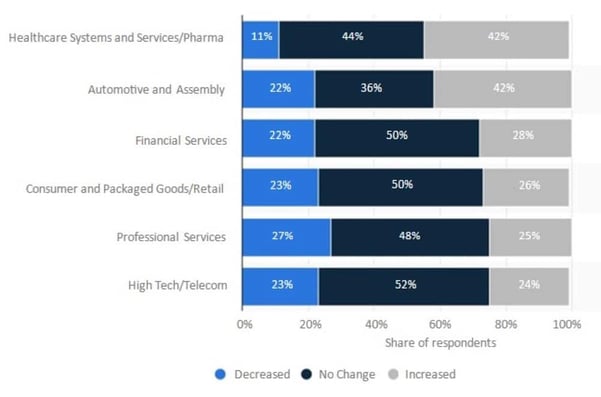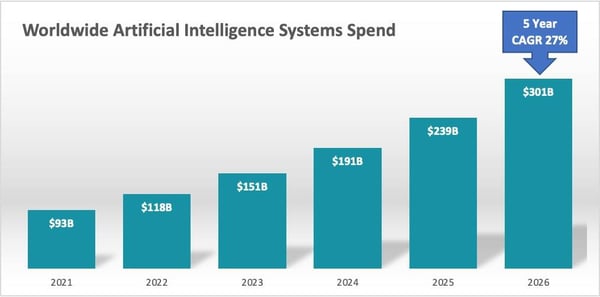Data should not be viewed as the “new oil,” only meant to be burned once; instead, it should be...
Why Corporate Leaders Should Invest in AI for Pandemic Recovery

What a pickle all of us are in. It has been more than two years since the pandemic hit the world and a global shutdown followed. But is this the case? Is the business in 2019 “normal” as we previously knew it to be? And where does AI fit into this equation?
The post-pandemic context for business
As the world recovers from the world pandemic and deals with a decreasing workforce, a global semiconductor shortage, and rising energy costs, pent-up demand driven by a hopeful consumer and corporate population has put tremendous pressure on margins. Of course, all of this comes after two years of revenue that was absent or considerably reduced for many. Due to the global recession, many companies are closing their doors and becoming less profitable.
Business leaders usually have to make tough choices on discretionary spending because survival is always on their minds. Innovation and investment are usually limited because they always include a level of unquantifiable risk and, more importantly, a lag in ROI, regardless of how strong the business case is. So that’s it. For the time being, at least, we should forget about everything innovation-related, including investments in AI capabilities.
But there has long been proof that businesses that invest and develop during such unsettling and tough times come out stronger and more resilient than they did before they encountered such trying circumstances. Over the years, a lot of industries, including customer packaged goods, automotive, retail, and technology, have seen increases in sales and market share. For instance, this approach was once followed by Kellogg’s, Toyota, and Walmart. But what can we anticipate right now? What can we especially anticipate in terms of AI?
Could businesses be using AI to create their way out of trouble?
It’s interesting to note that data indicates that companies are still hopeful about AI and want to increase their investments in this post-pandemic economy, in addition to maintaining their current levels.

Figure 1: Change in investment level of artificial intelligence (AI) in organizations worldwide due to the COVID-19 pandemic in 2020, by industry. Source: Statista 2022.
What does this mean, then? What is the current state of AI spending and how much is expected to be spent on AI in the upcoming years? IDC reveals the following trend:

Figure 2: Worldwide AI Systems Spend. Source: IDC – Worldwide Artificial Intelligence Spending Guide (September 2022)
What business leaders need is some proof of what types of innovation produce a demonstrable return, a short time to pay back, and ideally, a low cost of entry.
Enter artificial intelligence (AI), or more specifically, new strategies for how businesses can quickly and affordably acquire AI capabilities. In order to deliver AI in methods that minimize the need for significant investment and, in some cases, do not require any investment at all, technology vendors have been working hard in this area. They offer the tools and pre-built outputs.
Simpler but better
Of course, the foundations stay relevant. AI needs to be welcomed and used throughout the entire company if it is to produce a significant return. Solutions must fit your business model and complement your employees to accomplish this without friction. Naturally, the better the answer, the easier it will be to implement. Low entry costs and general acknowledgment are strongly correlated with simplicity.
The skills necessary to create and maintain machine learning models, as well as the modifications to infrastructure and capital investment necessary to conduct asset calculations and produce outputs, are usually issues for organizations looking to start using AI or increase its use (often in real-time).
Today, businesses that wish to use AI may do so by using safe third-party infrastructure, which offers all the parts needed to create and maintain comprehensive AI solutions (including a machine-learning production pipeline). They may “rent rather than buy” the necessary infrastructure with the help of their in-house data science team, cutting costs to an absolute minimum while keeping the performance and security of their basic infrastructure, which supports their core business.
Also, the cost of admission is far from being prohibitive because so many suppliers now provide highly competitive payment methods. For a system that works for you, shop around and select the best combination of security, performance, and cost-effectiveness.
The value of embedded AI
By integrating AI into other products, technology companies are also assisting organizations in acquiring these capabilities for free. In many cases, AI has transformed from a pay-for-extra to a “value-add” collection of features within more general business software. Customer vendors are paying close attention to the workflows of their primary user personas and using AI to speed up these processes and surface important information to help these users be more productive in their everyday tasks.
These capabilities are being included in both front- and back-office software so that companies can improve productivity throughout their entire organization. Embedded AI is offering organizations a clever way to acquire fully operational AI capabilities precisely where they are needed, at the precise time they are needed, and, in many cases, at zero incremental cost. AI outputs surface automatically in software environments already familiar to personnel in finance, recruitment, talent management, procurement, sales, and marketing.
In this approach, a wide range of AI-powered capabilities is now accessible, offering a variety of helpful data suited to the user’s position. For instance, in the financial industry, the account payables team’s manual data entry uses up a lot of bandwidth. Each AP clerk might save double-digit amounts of time by using complete or partial predictive data entry to make sure the correct client account codes are entered. The lengthy and usually manual nature of the recruiting process is sometimes contested in recruitment. Here, AI is enabling front-end screening before in-person interviews by enabling a fully automated procedure to fully analyze every single candidate’s resume. A wonderful example of how AI can oppose the realities of human behavior when engaging with a firm is in customer service, where it can be used to counteract how customers send SRs (typically via email rather than the ticketing system). Finally, AI-powered scoring models are giving businesses a new way to score prospects and customers in sales and marketing. These models also offer helpful advice in the form of on-screen suggestions for the best course of action to close a deal.
AI can be a helpful antidote to the current commercial and economic difficulties. It might not be a vaccination as we know them, but it gives companies the ability to organize more, improve service levels, save costs, and increase profitability. Perhaps this makes it the medicine we all need right now to make us more robust the next time. Businesses cannot afford to delay innovation in the field of artificial intelligence (AI).
Here at CourseMonster, we know how hard it may be to find the right time and funds for training. We provide effective training programs that enable you to select the training option that best meets the demands of your company.
For more information, please get in touch with one of our course advisers today or contact us at training@coursemonster.com
